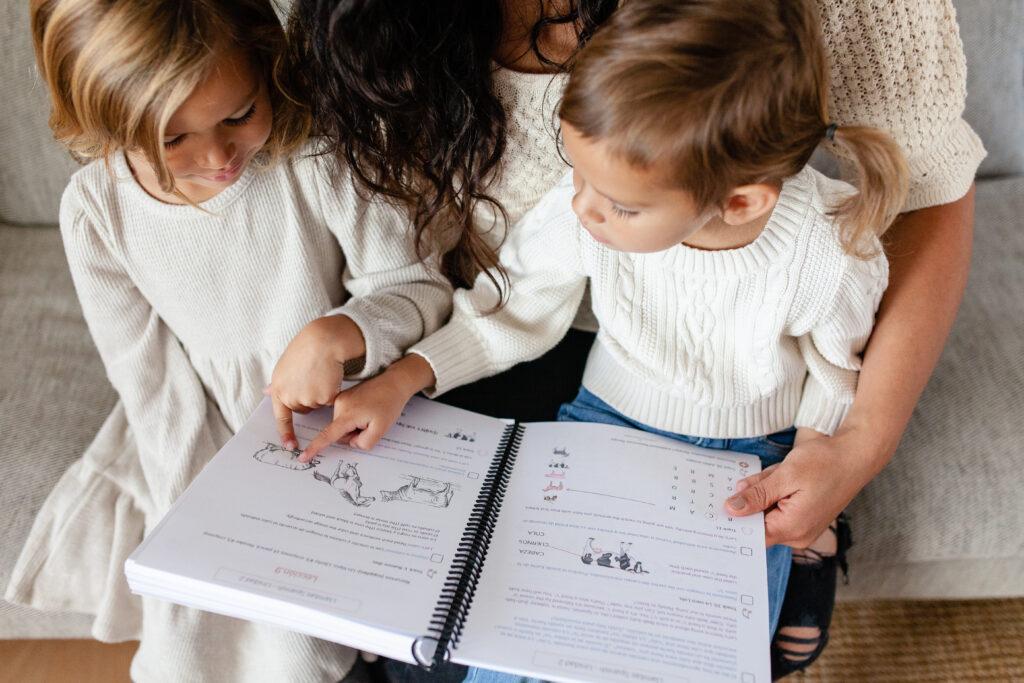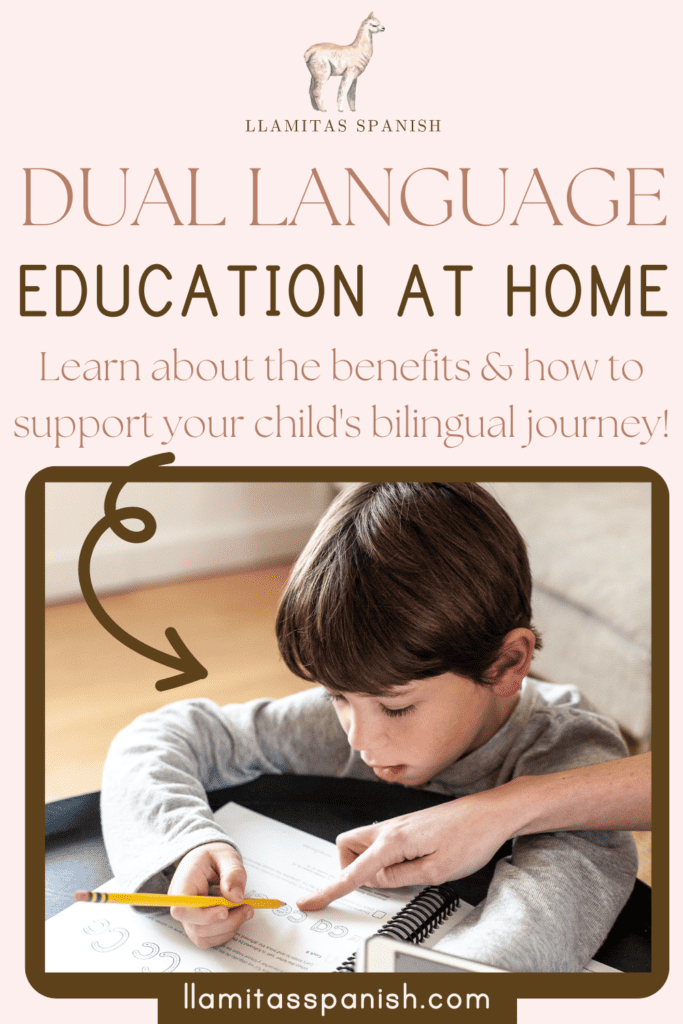In this post: Learn about the benefits of a dual language education and how you can use this approach at home to support your child’s biliteracy.
As the benefits of bilingualism become more widely understood, more and more US families are choosing to raise their children bilingual.

The rise of bilingualism has led to a growing number of dual language immersion (DLI) programs across the country. These can be a fantastic way to support your child’s biliteracy if you have one of these programs available to you.
But many parents are also choosing to homeschool their children in two (or more) languages, too. If you’re thinking of adding a foreign language to your homeschool curriculum or actually giving your child a dual language education at home, you’re in the right place!
Related post: Dual Language Schools in San Diego County
Table of Contents
What is Dual Language Education?
Dual language education, sometimes called bilingual education, is an academic program in which students are taught in two languages—the students’ native language as well as a target language (partner language).
This doesn’t mean taking a Spanish class, for example, alongside other subjects. Instead, dual language programs immerse students in their target language across subjects. Students learn all subjects in two languages, including math, science, social studies, and of course literacy.
With all of the known benefits of bilingualism, it’s no wonder these types of programs are on the rise.
According to a 2021 report by the American Councils for International Education, there are over 3,600 dual language immersion (DLI) programs across the US. States with the most DLI programs are California, Texas, New York, Utah, and North Carolina. It also comes as no surprise that Spanish is the most popular partner language, with Spanish programs making up about 80% of DLI programs across the country.
Types of Dual Language Programs
While the basic idea stays the same, dual language programs differ in how they work and who they serve. For example, there are four basic types of dual language programs:
- Developmental (Maintenance): for English language learners who primarily speak the partner language at home to maintain skills in both languages
- Two-Way Dual Language Immersion: includes an even mix of both native English speakers and native speakers of the partner language
- Foreign Language Immersion (One-Way Immersion): for native English speakers to learn the partner language as a foreign language
- Heritage: for students who primarily speak English but have a family background in the partner language
In a dual language program, the target language is used at least 50% of the time, and English is used at least 10% of the time.
However, this can vary depending on the program and even grade levels. Often, the target language (such as Spanish) is the primary focus in the early years, with some programs using it up to 90% of the time. By about third grade, this often evens out to about 50/50 English and Spanish.
What is the Purpose of a Dual Language Education?
The most obvious purpose of a dual language education is for students to become proficient in two languages, both bilingual and biliterate. Being fluent in two languages has so many benefits, from improving linguistic skills and other cognitive abilities to opening up future career opportunities in an increasingly globalized society.
But many dual language programs go beyond simply teaching academics, by also raising students to become global citizens. A focus on cultural appreciation and diversity is often an important aspect of a bilingual education.
Related post: Bilingual Homeschooling Moms
Advantages of Homeschooling in Two Languages
Now that you know a little more about dual language education and how it works, you might be wondering: can you do all of this at home? While homeschooling will always look a bit different from a public school setting, the answer is yes! You can homeschool in two languages and enjoy the benefits of a dual language education.
One of the many great things about homeschooling is the flexibility—maybe this was one of the reasons why you began your homeschooling journey in the first place. You have the freedom to choose how you teach your children, and this can absolutely mean teaching them in two languages.
Here are some advantages you can enjoy when homeschooling in two languages:
Flexibility: Again, homeschooling means you have the freedom to choose how you teach your child. Whether you want to do 50/50 Spanish and English, 90/10, or anything in between, that’s totally up to you—and you can change things later if something isn’t working for your family.
Individualized Attention: You know how your child learns best and know their skill level, so there’s no guesswork or “teaching to the middle” to try and meet different students’ needs.
Following Your Child’s Interests: Applying language learning to topics that your child finds interesting will make it much more meaningful for them. You can even let them choose which language they’d like to learn if you don’t have a preference.
Starting Early: While you may be lucky enough to live near a DLI program for young learners, many schools don’t offer a foreign language until students are older. But learning a second language is often easier for young children. You can get started during this critical language learning period on your own by homeschooling.
There are so many benefits of bilingualism, and teaching your child a second language is a gift that they can enjoy for the rest of their life.
While you don’t need to enroll your child in a DLI program for them to become bilingual, sometimes having a little bit of help can go a long way. This is why at Llamitas Spanish, we support families raising bilingual children by providing academic, authentic, and beautiful Spanish curricula.
Will Learning in Two Languages Confuse My Child?
Some parents might be concerned about bilingual children becoming confused, but you can rest assured that this is absolutely not true! Learning two languages does not confuse children or inhibit learning.
In fact, research has found that bilingual children actually have advanced linguistic, cognitive, and social-emotional skills when compared to their monolingual peers. Even young babies who are raised bilingual have been shown to have greater cognitive flexibility—the ability to adapt to changes and switch tasks—than monolingual infants (Espinosa 2015).
Related post: Should Your Kids be Learning Phonics in English and Spanish at the Same Time?
Related post: 10 Myths about Raising Bilingual Children

Cross-Curricular Approach to Language Learning
In a dual language education, students are immersed in their target language because it’s applied across subjects. DLI programs use a cross-curricular approach, with students learning all subjects—from math to science and even art—in both languages.
This allows students to learn language in context, in a way that’s natural, meaningful, and enjoyable. They aren’t simply memorizing vocabulary or drilling verb conjugation charts but are instead able to apply and truly understand the material, thus committing it to their long-term memory.
Likewise, our Llamitas Spanish curricula for the early years use a cross-curricular, thematic approach to learning Spanish. Lessons cover literacy, music, math, phonics, art, geography and more, so kids can apply their language skills to fun and fascinating topics that interest them.
For example, in our Level 2 Curriculum, students learn about the Amazon rainforest, nocturnal animals, and how to tell time—all in Spanish. In another lesson, they’ll learn all about cities like Barcelona, as well as their architecture, while also gaining practical Spanish skills like giving directions.
With thematic instruction, language learning becomes more hands-on, memorable, and fun for kids, leading to much better outcomes in the long-run.
Llamitas Spanish Early Years Curriculum
Ready to implement a dual language education at home, but need the support of a done-for-you curriculum will help you along the way? Our Llamitas Spanish Early Years Curriculum has everything you need to support the DLI trajectory as a bilingual homeschooling family.
Our beautifully illustrated, open & go curricula were designed with young learners (preschool through early elementary grades) in mind. Whether you’re just getting started adding a foreign language to your homeschooling and don’t know any Spanish OR you’re a bilingual family looking for support in teaching your kids, we’ve got you covered!
Age-appropriate, fascinating, thematic lessons that are rooted in authentic Hispanic culture will allow you to seamlessly teach your child two languages at home so they can reap the benefits of a bilingual education.
Let us take all of the prep-work and planning out of the equation, so you can focus on supporting your child’s biliteracy! Visit the curriculum shop today!




